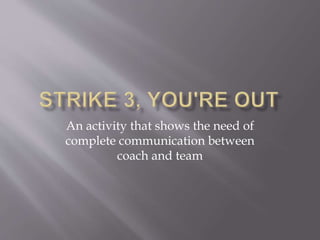Strike 3, you're out
•Download as PPTX, PDF•
0 likes•29 views
This activity demonstrates the importance of clear communication between coaches and teams. Participants are split into groups and given balloons to inflate, with the goal of producing the most "acceptable" balloons as judged by their coach. However, the coaches are not given clear instructions on what qualifies as acceptable. As a result, teams become frustrated as their balloons are popped without understanding the criteria. A discussion afterwards reveals that lack of understanding caused lower productivity and negative emotions. The key lessons are that effective coaching requires setting specific standards and ensuring teams comprehend expectations.
Report
Share
Report
Share

Recommended
More Related Content
What's hot
What's hot (15)
De refter 5 minute training - training - train - the trainer

De refter 5 minute training - training - train - the trainer
Social Security Administration Facilitator Training

Social Security Administration Facilitator Training
Coaching For Pinacle Performance By Ravinder Tulsiani

Coaching For Pinacle Performance By Ravinder Tulsiani
Effective Problem Solving & Decision Making (ACE-4) PPT .pdf

Effective Problem Solving & Decision Making (ACE-4) PPT .pdf
Similar to Strike 3, you're out
Similar to Strike 3, you're out (20)
Basic Leader Course (BLC) Play video in the video folder.docx

Basic Leader Course (BLC) Play video in the video folder.docx
H I G H P E R F O R M A N C E L E A D E R S H I P P R E S E N T A T I O N

H I G H P E R F O R M A N C E L E A D E R S H I P P R E S E N T A T I O N
Resilience Resilience is not only needed in the business wor.docx

Resilience Resilience is not only needed in the business wor.docx
Strike 3, you're out
- 1. An activity that shows the need of complete communication between coach and team
- 2. By end of this activity, you will be able to: Describe the need for complete and open communication Experience the frustration of someone who is asked to perform to standards that are not known Appreciate team effort Describe the attributes of an effective coach
- 3. Copy of exercise for coach Balloons of the same size (12 for each participant) Straight pins )or any sharp object) Scorekeeping device
- 4. Divide the participants into groups of five, explain that each team will have a coach and the team’s goal will be to produce more ‘acceptable’ inflated balloons than the opposing teams. Give 12 balloons to each participant. They will be given 5 minutes to produce balloons. Each team can select a coach.
- 5. Take coaches out of the room and give them instructions for what will be judged as an acceptable inflated balloon. They will also receive a pin or sharp object. The only feedback they are allowed to give their team is approval or rejection of balloons, rejection will be coach popping balloon.
- 6. Tell the teams that their coach will accept only those balloons that meet the criteria; only acceptable balloons will count. If the participants ask what constitutes ‘acceptable’ tell them that their coach will give them constant feedback concerning the acceptability of the balloon.
- 7. An acceptable balloon is fully inflated and held high other their heads
- 8. The participants will want verbal feedback and will become increasingly frustrated as unacceptable balloons are popped. Some teams will attempt to uncover the riddle of what makes a balloon acceptable. Some teams will give up as they become fearful of the reprimand.
- 9. Congratulate the winning team. In response to the complaints about the lack of fairness, ask for feedback. What problems did you have with production? What would have facilitated production? What caused frustration, anxiety, or confusion?
- 10. Ask the participants to describe: What just happened? What was learned? Why was this activity conducted? Lead a discussion about the necessity of complete and fully understood communication for team and individual production. Lead the participants in understanding and discussing the attributes of the effective coach as a person who sets specific standards and makes sure that those standards are fully understood and accepted by the employees.
- 11. The concepts learned should be those that emerged from the discussion. Focus on how understanding can be applied on the job. Some possibilities could be: Effective communication should be specific Employees want to know what is expected of them Ineffective communication results in lower productivity Ineffective communication causes people to become frustrated, fearful and resentful